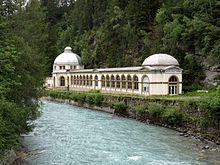Bernhard Simon (architect)
Bernhard Simon (born February 29, 1816 in Niederurnen ; died July 28, 1900 in Bad Ragaz ) was a Swiss architect and engineer . After he had made his fortune in St. Petersburg , he became, back in Switzerland, railway operations director, politician, building contractor and finally, as the (re) founder of the spa tradition in Bad Ragaz, one of the protagonists of spa tourism in Switzerland in the 19th century.
Life
Bernhard Simon was the son of a small farmer and shoemaker in Glarus. At a time when there was no academically regulated architectural training in Switzerland, he acquired his knowledge in Lausanne, where his uncle Fridolin Simon was building inspector. In 1835 he began an apprenticeship as plasterer and bricklayer there, and in the following year he took over as his uncle's deputy. In addition, he was able to take over the construction management of the buildings of his sick colleague Henri Fraisse , namely the Hotel "Gibbon" and the "Kornhaus".
In 1839, after a short study trip to Paris , he moved to St. Petersburg , where he initially found employment with Georg Ruprecht Zollikofer (1802–1874) from St. Gallen. A few months later he went into business for himself. The soon-to-be successful office - Bernhard Simon later brought his brothers Balthasar and Sebastian to Russia - became one of the busiest offices in St. Petersburg of the era, primarily planning residential buildings for noble clients. The most important works of the architect during this time were the interiors of the palaces Yusupov and Shuvalow (1844–1846) as well as a new palace and the reconstruction of the country villa of Count Voronzow-Dashkow in Bykowo near Moscow (1847–1856). In 1853 Simon became a member of the Imperial Academy. His work from this time is still awaiting scientific analysis.
In 1854 Simon returned to Switzerland for health reasons. On the mediation of his friend, the travel writer Iwan von Tschudi , he moved to St. Gallen and received citizenship there in 1855. As the supervisory board member responsible for construction, he was responsible for the construction work on the Rorschach – St. Gallen – Winterthur and, after the opening, operations director. He was probably a restless and meticulous tackle. In any case, the Landbote wrote about him in 1859: "No switchman was certain, day or night, of being surprised by his visit or inspection." However, after the merger to form the United Swiss Railways, he missed the position of general manager, which is why he returned to his profession as an architect and at the same time worked as an entrepreneur.
In the vicinity of the St. Gallen train station, he built the “Simon Quarter”, later named after him, with commercial and residential buildings as well as the city's post office on his own account from 1859 to 1862. In 1861 he was also one of the two architects who planned the reconstruction of Glarus after the devastating village fire , alongside the Zurich State Building Inspector Johann Caspar Wolff . In addition to the general plans and the building regulations, he planned the town hall there and, as a general contractor, built the reformed city church according to plans by Ferdinand Stadler . In the 1860s he also planned the post office building in Lausanne (1864) and the cantonal hospital in St. Gallen (1867).
In 1868 he retired from the St. Gallen business world, in that year he also resigned from his council seat. The reason for this was the takeover of the Hof Ragaz domain and the concession for Bad Pfäfers , which had passed to the canton of St. Gallen after secularization . As a spa entrepreneur, he built the luxury hotel " Quellenhof " there in 1869 , followed by the Kursaal, thermal swimming pool and parks. From then on, in addition to taking care of the spa, he only worked once as an architect, for the Kurhaus and the drinking hall, the "Bavetta", in Tarasp in the mid-1870s.
Selection of works
- Villa Charlottenfels , Neuhausen 1850–1854
- Residential and commercial buildings , St. Gallen 1859–1860
- Hotel Walhalla and old post office, St. Gallen 1860–1861 (destroyed by fire in 1955)
- Glarus , reconstruction planning 1861–1863
- Glarus town hall 1862–1864
- Hotel Quellenhof , Bad Ragaz 1868–1869 (demolished in 1995)
- Bavetta , Trinkhalle and Kurhaus, Tarasp 1874–1877
literature
- Benno Schubiger: Simon, Bernhard. In: Isabelle Rucki and Dorothee Huber (eds.): Architectural Lexicon of Switzerland - 19./20. Century. Birkhäuser, Basel 1998. ISBN 3-7643-5261-2 . P. 498 f.
Web links
- Benno Schubiger: Bernhard Simon. In: Historical Lexicon of Switzerland .
- Portrait of the entrepreneur on www.badragaz.ch, accessed on March 6, 2016
supporting documents
- ^ Tagblatt der Stadt St. Gallen 1859. S. 1516. Quoted from Peter Röllin, Daniel Studer: Inventory of the newer Swiss architecture , 1850–1920 . St. Gallen. In: Society for Swiss Art History (Ed.): INSA . tape 8 . Orell Füssli, Zurich 1996, ISBN 3-280-02410-2 , p. 57 , col. 2 , doi : 10.5169 / seals-9217 ( e-periodica.ch [accessed on March 8, 2016]).
| personal data | |
|---|---|
| SURNAME | Simon, Bernhard |
| BRIEF DESCRIPTION | Swiss architect and engineer |
| DATE OF BIRTH | February 29, 1816 |
| PLACE OF BIRTH | Niederurnen |
| DATE OF DEATH | July 28, 1900 |
| Place of death | Bad Ragaz |


